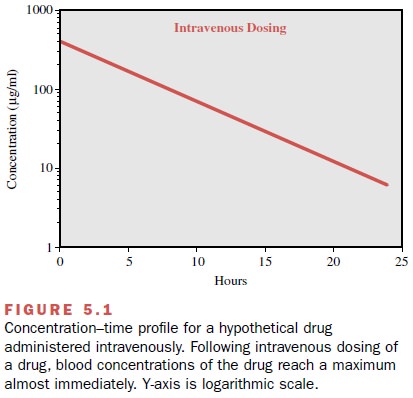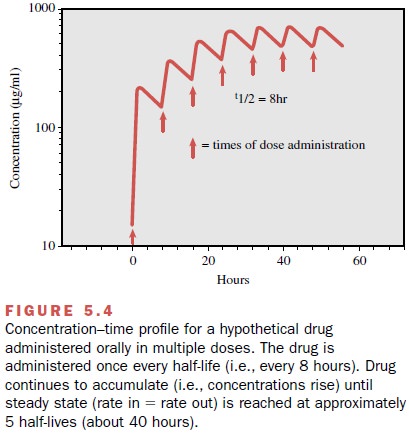Chapter: Modern Pharmacology with Clinical Applications: Pharmacokinetics
Pharmacokinetics of Single Versus Multiple Dosing
PHARMACOKINETICS
OF SINGLE VERSUS MULTIPLE DOSING
Administration of single
doses of a drug are occasion-ally encountered in clinical practice, but it is
more com-mon to use single doses to determine the pharmacoki- netic profile of
a drug. Figures 5.1 and 5.2 illustrate such a use of single doses. Following a
single dose, concen-trations can be monitored until no longer analytically detectable
and a complete pharmacokinetic profile is described.


In clinical practice, drugs
are more commonly ad-ministered in multiple doses, with the second dose
usu-ally given before the first dose is completely eliminated. Figure 5.4 shows
a representative time–concentration profile for multiple dosing of a drug with
a t1/2 of 8 hours. With each successive dose up to approximately
five doses, the concentration of drug keeps increasing, a phenomenon known as
accumulation. The final concen-trations of drug reached depend on the
elimination rate of the drug, the dosing frequency, and the actual dose. Thus,
for a given drug, concentrations will
reach higher steady-state values if the drug is given more frequently or in
greater doses. In contrast, the time
to reach steady state is affected by neither the dose amount nor dosing
frequency. The time to reach steady state is solely af-fected by the
elimination rate (which is reflected in the t1/2). Giving a larger
dose or giving the dose more often will not change the time needed to reach
steady state (except in the case of a bolus dose, as discussed later).

Just as it takes approximately five half-lives for a drug to be essentially (97%) eliminated, it also requires five half-lives for a drug to reach steady state. This is ex-emplified in the concentration–time profiles of Figure 5.4. The hypothetical drug in this example has a half-life of 8 hours and is dosed every 8 hours. The graph shows that at about 40 hours (five half-lives), the maximum and minimum concentrations become consistent, indicating achievement of a steady state of concentration (drug input drug elimination).

The only practical method for
achieving steady-state concentrations prior to five half-lives is to administer
a bolus dose of drug (a dose much higher than normal and designed to bring
concentrations up to steady state immediately) followed by standard dosing
(Figure 5.5). In this way, the “accumulation” of drug occurs rapidly because of
the large amount of drug given initially. However, bolus doses must be
calculated in accordance with both the drug’s pharmacokinetic parameters and
the physiological characteristics of the individual to avoid potential
toxicities.
Related Topics